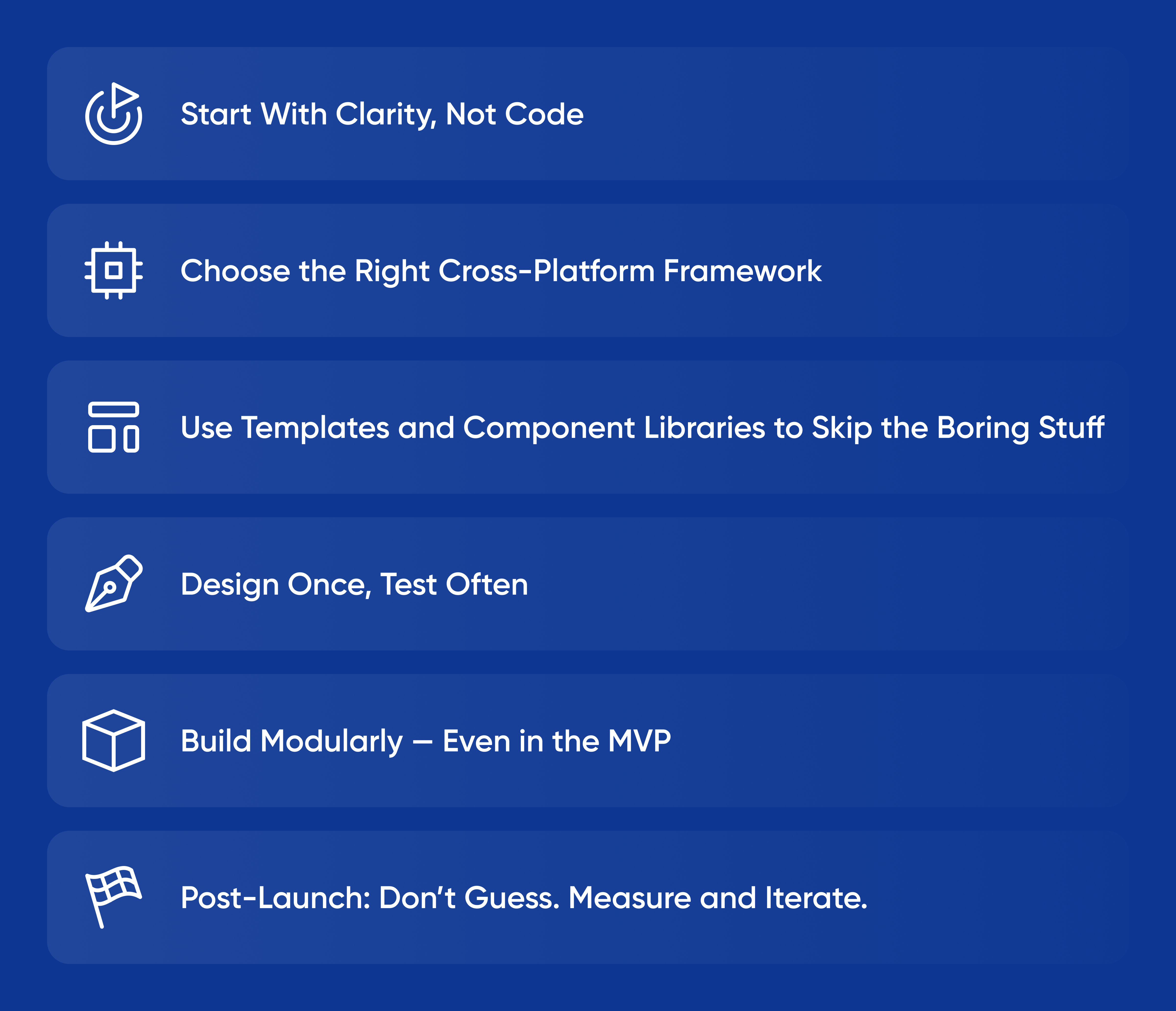Speed is the lifeblood of early-stage startups. But in the race to launch quickly, many founders end up making painful trade-offs: janky UI, poor performance, brittle architecture, or technical debt that becomes impossible to untangle later.
But what if you didn’t have to choose between moving fast and building well?
In 2025, building a high-quality MVP doesn’t have to take six months or two full-stack teams. Thanks to the maturity of cross-platform frameworks, lean methodologies, and smarter tooling, it’s now possible to launch a polished, user-ready MVP for both iOS and Android in weeks — not months.
At Movadex, we’ve helped startups go from concept to app store with fast, focused MVPs that users actually love. Here's how to do it right — fast, without wrecking your future.

Start With Clarity, Not Code
The biggest time-waster in early product development isn’t the tech. It’s indecision.
Before you write a single line of code, define exactly what success looks like for your MVP. What’s the core problem you’re solving? What’s the one outcome you need users to experience to prove you’re on the right track?
Strip your vision down to its most essential behavior. Everything else — advanced dashboards, multiple user roles, social logins, push notifications — can wait.
Your MVP is not your vision. It’s a test.
Choose the Right Cross-Platform Framework
In 2025, you’ve got two clear leaders: Flutter and React Native.
-
Flutter is great if you want rich visuals and precise control over UI across platforms. It’s ideal for fintech, e-commerce, or anything with custom design elements.
-
React Native is perfect if your team already knows JavaScript or React, or if you’re planning to build a web app in parallel.
Don’t overthink it. Both can get the job done for 90% of MVPs. Choose based on your team’s comfort and available talent. The goal is to start building, not to architect perfection.
Use Templates and Component Libraries to Skip the Boring Stuff
You’re not building your own design system from scratch (yet). For now, speed matters.
-
Use FlutterFlow or Draftbit if you want low-code acceleration.
-
Use Expo for React Native to avoid the native build headaches.
-
Leverage libraries like React Native Paper or Flutter’s Material package for ready-to-use components.
This doesn’t mean your app will look generic — it means you can focus your effort on what makes your product unique, not reinventing buttons and inputs.
Design Once, Test Often
Don’t design in isolation for weeks. Create a clickable prototype (Figma works great), share it with real users, and refine it quickly. Then hand it off to your dev team with feedback baked in.
Design is not just about how it looks — it’s about reducing friction in the flow. Your MVP should have the shortest path to value possible. No fluff. No confusion. No wasted screens.
At Movadex, we test prototypes with 3–5 real users before we commit to development. This one step alone has saved our clients weeks of rework and clarified the MVP scope dramatically.
Build Modularly — Even in the MVP
It’s tempting to write everything in one file just to get it done. But a tiny bit of discipline here pays off later.
Organize your app into modules: auth, onboarding, core features. Keep logic and UI separate. Use folders and naming conventions.
This way, when you inevitably update a feature or add something post-launch, you won’t waste hours untangling spaghetti code.
It doesn’t need to be enterprise-grade — it just needs to be clean enough to grow.
Add Analytics and Error Tracking From Day One
Don’t wait until you scale to understand how people use your app. Use tools like:
-
Firebase Analytics for core engagement tracking
-
Sentry or Bugsnag for crash reporting
-
LogRocket or Instabug for capturing UX bugs
Even at MVP stage, this feedback is gold. It helps you identify what’s working, what’s broken, and what users care about — in real time.
Make Launch Simple, Not Perfect
Getting to the App Store or Google Play isn’t the finish line — it’s the starting gun.
Your first version doesn’t need to be viral. It needs to be shippable. That means:
-
The app installs smoothly
-
The core experience works consistently
-
You can gather feedback without firefighting every day
Use tools like Expo Go or TestFlight to beta test. Deploy with a manual review checklist. Keep your changelog clean. Have a clear feedback channel (even if it’s just a Google Form).
Post-Launch: Don’t Guess. Measure and Iterate.
After your MVP is in users’ hands, your job shifts. Now it’s about learning.
Watch what users do — not just what they say. Where do they get stuck? What do they repeat? What do they ignore entirely?
Use those insights to plan your next sprint. Sometimes, your next move is a small UX fix that doubles retention. Other times, it's cutting a feature you loved but users didn’t.
Fast MVPs only win if they evolve. Keep shipping. Keep listening.
Final Thought: Ship Fast, But Don’t Compromise on Core Quality
A cross-platform MVP should be lean — but it should also be something you’re proud to show. You don’t need every feature. But the core experience should feel stable, intuitive, and polished enough to earn trust.
At Movadex, we help founders launch cross-platform MVPs that look and feel like products — not prototypes. Whether you’re validating an idea, raising your first round, or entering a new market, we’ll help you move fast without compromising what matters most: your users’ experience.




